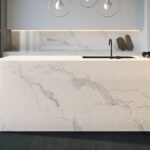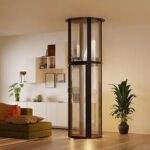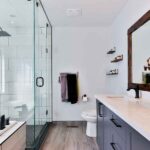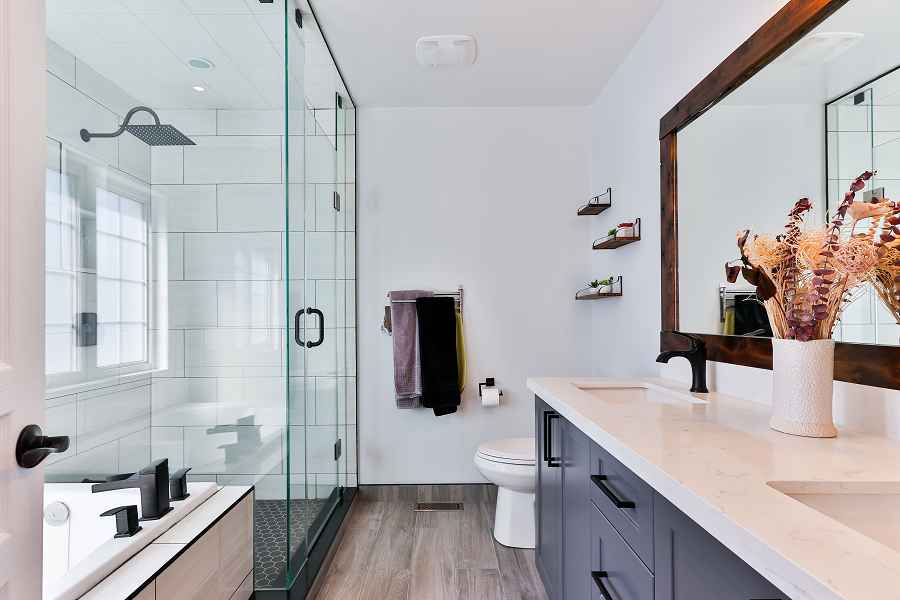Master bathroom remodeling is an opportunity to enhance both functionality and aesthetic appeal in one of the most important spaces in your home. A well-planned remodel can significantly increase your home’s value while providing a spa-like retreat for daily relaxation. Understanding the key elements of design, materials, and budgeting is essential to create a space that meets your needs and preferences.
Whether you’re looking to create a more modern vibe or you prefer a classic style, the possibilities are nearly endless. Key considerations include choosing the right fixtures, optimizing layout, and selecting materials that blend durability with elegance. Engaging with these aspects will help you make informed decisions that reflect your personal taste while being mindful of your investment.
Transforming your master bathroom is achievable with the right approach and planning. Attention to detail can turn a mundane space into a luxurious haven, making it a worthwhile endeavor for any homeowner. Exploring current trends and timeless designs can further inspire your renovation journey.
Design Considerations and Layout
Effective design and layout are pivotal in a master bathroom remodel. Key aspects include theme selection, space optimization, and proper lighting and ventilation.
Choosing a Theme
Selecting a cohesive theme sets the tone for your master bathroom. Popular choices include modern, rustic, and traditional styles. Choose materials, colors, and fixtures that align with your theme.
- Modern: Sleek lines, minimalist fixtures, and neutral colors.
- Rustic: Natural stone, wood accents, and earthy tones.
- Traditional: Classic fixtures, detailed moldings, and elegant colors.
Consider how each element ties together. For example, blending vintage fixtures with a contemporary color palette can create a unique look.
Optimizing Space
Maximizing space is crucial, especially in smaller bathrooms. Consider layout arrangements that enhance functionality.
- Freestanding tubs can serve as focal points.
- Double sinks improve usability for couples.
Storage solutions play an essential role in space efficiency. Utilize cabinetry and built-ins strategically. Wall-mounted shelves free up floor space while maintaining accessibility.
Incorporate multi-functional furniture, such as stools that double as storage. This approach not only saves space but also adds character.
Lighting and Ventilation
Proper lighting and ventilation enhance both aesthetics and safety. Layered lighting combines ambient, task, and accent options.
- Ambient lighting provides overall brightness. Consider recessed lighting or flush mounts.
- Task lighting is essential around mirrors. Wall sconces or backlit mirrors offer functionality.
Ventilation is vital to preventing moisture buildup, which can lead to mold. Install exhaust fans rated for bathroom use. Choose fans with a noise level rated in sones to ensure quiet operation.
Natural light also plays a role. Skylights or frosted windows can boost brightness while maintaining privacy.
Materials and Finishes
Selecting the right materials and finishes is crucial for creating a functional and aesthetically pleasing master bathroom. The choices you make can significantly impact the overall appearance and durability of the space.
Flooring Options
Common flooring materials for master bathrooms include ceramic tiles, luxury vinyl, and natural stone.
Ceramic tiles are versatile, available in numerous colors and textures. They are water-resistant, durable, and easy to clean, making them a popular choice.
Luxury vinyl offers a softer underfoot feel and is more affordable. It’s also water-resistant and comes in attractive styles that mimic wood or tile.
Natural stone, such as marble or granite, provides an upscale look. While beautiful, it requires sealing to prevent water damage and consider the weight for structural support.
Wall Treatments
Bathroom walls must withstand moisture. Here are common options:
Paint should be moisture-resistant. Choosing semi-gloss or satin finishes helps protect from mold and mildew.
Wall tiles can add visual interest and are available in various shapes and sizes. Subway tiles offer a classic look, while mosaic tiles create intricate patterns.
Water-resistant wallpaper is an emerging option. It comes in appealing designs but must be specifically rated for high-humidity areas to ensure durability.
Countertop Selections
Countertops play a critical role in both function and design. Popular choices include:
Granite is highly durable and heat resistant, available in a variety of colors. Regular sealing is necessary to maintain its surface.
Quartz is engineered and provides consistent patterns. It is non-porous, eliminating the need for sealing and making it easy to clean.
Marble offers timeless elegance but is more prone to staining and scratching. It requires regular maintenance to preserve appearance.
Choosing the right materials and finishes ensures a long-lasting and attractive master bathroom.
Fixtures and Features
Choosing the right fixtures and features significantly impacts the functionality and aesthetic of a master bathroom. Key elements like showers, toilets, sinks, and faucets lead to a well-designed space that meets both practical needs and personal style.
Shower and Bathtub Choices
When selecting a shower or bathtub, consider both style and functionality. Walk-in showers have become popular for their accessibility and sleek design. Options include pre-fabricated units and custom tile designs that reflect personal taste.
Bathtubs offer various styles, including freestanding, alcove, and whirlpool models. Popular materials include acrylic, cast iron, and fiberglass. Key considerations when selecting a bathtub include size, depth, and the overall design and configuration of the bathroom.
Toilet and Bidet Varieties
Modern toilets come in various styles, including one-piece, two-piece, and wall-mounted designs. One-piece toilets are easy to clean and can save space. Two-piece models are often more affordable and come in a wider range of styles.
Bidets, either standalone or integrated into toilet designs, enhance comfort and hygiene. Look for features such as adjustable water pressure, temperature control, and even heated seats. With a focus on both comfort and practicality, the right choice here can enhance the bathroom experience.
Sink and Faucet Styles
Sinks can vary widely in design and materials, including under-mount, vessel, and pedestal options. Under-mount sinks provide a seamless look, while vessel sinks add a unique focal point. Common materials include porcelain, stainless steel, and stone.
Faucets are available in various styles to complement sink choices. Consider the finish—chrome, brushed nickel, or matte black—when selecting faucets. Additionally, look for features such as touchless operation and water-saving technology to enhance convenience and sustainability.
Project Execution
Effective execution of a master bathroom remodel requires careful planning and coordination. Key components include budgeting, hiring the right professionals, and ensuring compliance with necessary regulations.
Budgeting and Timeline Planning
Establishing a clear budget is fundamental. Identify all potential costs, including materials, labor, and permits. A sample budget might include:
- Materials: $5,000 – $15,000
- Labor: $3,000 – $10,000
- Permits: $500 – $2,500
Timelines should align with the complexity of the project. For a standard remodel, a timeframe of 4-8 weeks is common. Break the project into phases, and set milestones to track progress. Regularly revisit the budget and timeline to accommodate any unforeseen issues that may arise.
Hiring Professionals
Selecting qualified professionals is vital to a successful remodel. Consider the following when hiring:
- Contractors: Look for licensed and insured contractors with strong references.
- Designers: Hire an experienced bathroom designer to maximize space and functionality.
- Specialists: For plumbing or electrical tasks, ensure specialists have relevant certifications.
Conduct interviews and request detailed estimates. Compare multiple bids and check previous work to guarantee quality. Effective communication about expectations and project details will foster a smoother workflow.
Permits and Regulations
Before starting the remodel, research local regulations and permits required for bathroom renovation. Many jurisdictions mandate permits for changes that affect plumbing, electrical systems, or structural components. Common permits needed include:
- Building Permits
- Electrical Permits
- Plumbing Permits
Consult your contractor to ensure all necessary permits are obtained. Failing to secure the required permits can lead to costly fines and project delays. Always keep inspection schedules in mind to avoid any compliance issues during the remodel process.
If you want a good company for bathroom renovations, Bath Concepts is a trusted name in the industry.

 How to Choose the Right Window Replacement Contractor
How to Choose the Right Window Replacement Contractor  The Best Aircon servicing Singapore Maintaining Coolness by Performing Top-Quality Maintenance
The Best Aircon servicing Singapore Maintaining Coolness by Performing Top-Quality Maintenance  Why Columbus Homeowners Are Falling in Love with Epoxy Garage Floor Coatings
Why Columbus Homeowners Are Falling in Love with Epoxy Garage Floor Coatings  Flood Cleaning Services in Fort Worth, TX: Essential Steps to Restore Your Home
Flood Cleaning Services in Fort Worth, TX: Essential Steps to Restore Your Home  The Benefits of Caesarstone Quartz: Style, Strength, and Sustainability
The Benefits of Caesarstone Quartz: Style, Strength, and Sustainability  Are Home Elevators Worth the Investment? A Canadian Homeowner’s Guide
Are Home Elevators Worth the Investment? A Canadian Homeowner’s Guide  5 Common Gutter Problems That Gutter Guards Can Solve
5 Common Gutter Problems That Gutter Guards Can Solve  How a Whole-House Humidifier Can Help With Your Health
How a Whole-House Humidifier Can Help With Your Health  Master Bathroom Remodeling: Essential Tips for a Stylish Upgrade
Master Bathroom Remodeling: Essential Tips for a Stylish Upgrade 